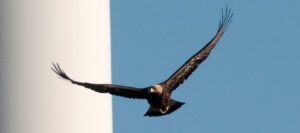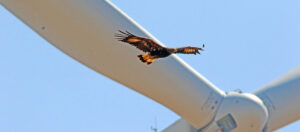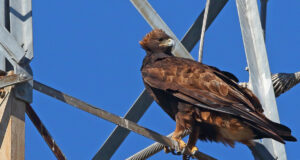Third International Scientific and Practical Conference “Eagles of the Palearctic: Study and Conservation”
Raptors Conservation. Suppl. 2. Proceedings of Conferences
Golden Eagles in the United States of America: Threats and the Federal Response to Potential Impacts from Renewable-Energy Development
Shaffer J.A. (U.S. Geological Survey, Northern Prairie Wildlife Research Center, Jamestown, North Dakota, USA)
Contact:
Jill Shaffer jshaffer@usgs.gov
Recommended citation: Shaffer J.A. Golden Eagles in the United States of America: Threats and the Federal Response to Potential Impacts from Renewable-Energy Development. – Raptors Conservation. 2023. S2: 425–427. DOI: 10.19074/1814-8654-2023-2-425-427 URL: http://rrrcn.ru/en/archives/35188
Golden Eagles (Aquila chrysaetos) have a Holarctic distribution. The subspecies A. ch. сanadensis North America, where it encounters the same anthropogenic threats as other eagle species worldwide, including electrocution on powerlines, shooting, collisions with vehicles, and poisoning by lead and rodenticides. A more recent threat is mortality from collisions with wind turbine blades. For the 11 States that are west of the 100th meridian and that represent most of the species’ year-round range within the coterminous United States of America (USA), over 600 individuals per year die from collisions with vehicles, wind-turbine blades, electrical power lines, and trains. Federal laws, policies, and guidelines aim to protect the Golden Eagle from the increasing threat of turbine mortality. Two Federal laws–the Migratory Bird Treaty Act and the Bald and Golden Eagle Protection Act–will be reviewed. The term “take”, which is defined as “pursue, shoot, shoot at, poison, wound, kill, capture, trap, collect, molest, or disturb” individual eagles, their parts, nests, or eggs will be further discussed.
Within the U.S. Department of the Interior, the U.S. Fish and Wildlife Agency issues guidelines and regulations aimed to protect Golden Eagles from “take” and to set thresholds for that “take.” Guidelines and policies particularly relevant to wind-energy development include the Land-Based Wind Energy Guidelines, the Eagle Conservation Plan, and the Mitigation Policy. Each of these guidelines and policies will be explained. Federal mitigation policy has a 3-tiered strategy summarized as “Avoid–Minimize–Mitigate.” Practices that exemplify each tier of the “Avoid–Minimize–Mitigate” strategy will be examined, including such practices as avoiding sites deemed of highest risk to cause harm, minimizing harm by such activities as turbine curtailment, and mitigating unavoidable “take” by engaging in mitigation banking. Currently, the only compensatory mitigation practice authorized by the U.S. Fish and Wildlife Service is the retrofitting of power poles. Thus, the Bald Eagle and Golden Eagle Electrocution Prevention In-lieu Fee Program, which retrofits power poles deemed of high-risk in causing electrocution of eagles, will be discussed. Other mitigation options worthy of consideration for future authorization also will be described.



